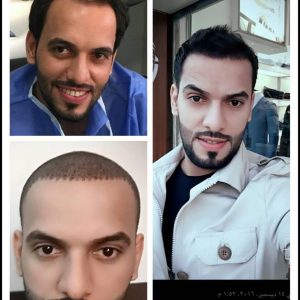Hair and eyebrow transplants
Hair Transplant
Hair Transplant :
Which hair transplant method is better?
The fact is that each person should, depending on his condition, such as baldness, scalp size, hair bank and the expectation and mentality of hair transplantation, according to the diagnosis of a specialist, one of the hair transplantation methods or a combination of several methods Choose
FIT hair transplant method
In a hair transplant called FIT, hair follicles or hair follicles, called FUGs, are removed individually from behind with a device called a “holder” or “punch” and implanted in areas without hair. In this method, which lasts several sessions, in fact, no surgery is performed and in each session, an average of 1000 to 1500 hair follicles are removed from the back and implanted in the desired areas.
It is a painless procedure with local anesthesia that is more useful for hair transplants in smaller areas such as the beard, eyebrows, eyelashes, mustache or those who do not have extensive baldness or when it is not possible to remove tissue from behind the patient for any reason.
Benefits of Hair Transplant Method: FIT
✓ Less pain
✓ Natural hair growth
Very little bleeding
No need for stitches and surgery
✓ More hair follicles are removed in consecutive sessions.
FUT hair transplant
In FUT or Follicular Unit Transplantation, a thin strip of skin tissue is removed from the back of the person and then converted into hair units or FUGs by an experienced doctor under hair transplant microscopes. Incisions are then made in the areas to be implanted and hair units or FUGs are implanted in these incisions.
Benefits of FUT hair transplantation
Experience over the years comparing the FIT and FUT hair transplants suggests that the FUT method in many ways, including scarring, graft drying time, graft percentage, and graft quality in terms of structure and texture. , Duration of operation, complications and even cost of operation are superior to FIT
The benefits of FUT hair transplantation are:
∗ Invisible hair transplant site
Create a natural line on the front of the head and its natural appearance
∗ Natural hair appearance and no dents or bumps on the scalp
∗ Ability to remove hair from the back of the head
∗ Maintain the quality of the grafts to repeat the planting if necessary
Disadvantages of FUT hair transplantation
The disadvantage of FUT hair transplantation is that it creates a large incision in the back of the head where there is a possibility of scarring or scarring. Of course, this problem can be covered by placing the hair in that area and raising the hair.
Complications of hair transplantation
There are no side effects if the hair transplant is performed by a specialist doctor and trained technicians approved by the doctor. Hair transplants should be performed by dermatologists and hairdressers, head and neck surgeons and plastic surgeons who have undergone skin and hair transplant surgery, in accordance with appropriate physical standards and equipment. However, hair transplantation is a medical procedure that, like other medical procedures, can cause problems in some cases. But many of these side effects are temporary
Ecessary care before hair transplantation
If you are a smoker, quit smoking two weeks before your hair transplant.
If you are taking vitamin E tablets or capsules, tell your doctor and stop taking them three weeks before the operation.
If you have a history of any disease, especially diseases such as diabetes, epilepsy and heart disease, talk to your doctor.
Tell your doctor before surgery if you are taking any medications such as aspirin or aspirin-containing medications.
Take a shower the day before the operation.
Do not use drugs such as ibuprofen or naproxen as the day before surgery.
If your doctor recommends that you use the FUT hair transplant, do not shave your hair for at least three weeks before the operation.
In other methods, follow your doctor’s instructions.
Eat a short but useful meal before hair transplantation.
Get enough rest the night before the hair transplant.
Before hair transplantation, it is better for the applicant to attend a consultation with the doctor. In this counseling session, issues such as the history of hereditary hair loss in relatives, the history of drug use for the treatment and evaluation of hormonal disorders (especially in women) will be evaluated.
✓ In this consultation session, the history of diseases as well as possible specific allergies or any effective factor will be reviewed in order to provide the best method and density for performing the implantation operation to the applicant.
. In the case of certain diseases, it is necessary to submit a form stating that natural hair transplant surgery is not prohibited, depending on the type of disease and the medication used for it, by the treating physician at the hair transplant clinic.
If there are conditions for hair transplantation, a blood test is requested to check for coagulation factors and dangerous and infectious viral diseases. The result of this test is checked by a hair transplant specialist and if the hair transplant operation is normal, it is unobstructed. It is very important to have this test and do it on time, and if the test is performed on more than one month from the time of referral, all tests must be repeated to confirm their accuracy.
Necessary care after hair transplantation
After the hair transplant operation, it is better to have someone with you to go home and preferably rest for the first three days.
For the first few nights when resting, place two soft pillows under your head so that you are half asleep.
Avoid strenuous activity that requires pressure and strain for up to a week after the hair transplant. Avoid excessive bending and straightening, severe coughing and sneezing, and rapid movements. Sweating causes an infection in the area of the implant and the wound.
✓ Do not tilt your head too far forward for up to two weeks as the scalp becomes stretched and the risk of scarring and scarring at the hair removal site increase.
Take prescribed medications as directed by your doctor.
✓ If you are taking iron pills, stop taking them for a week.
Wash your head daily with shampoo prescribed by your doctor, very gently and without manipulating the hair transplant site. You will be taught the correct way to wash your head by your doctor. The cobras at the hair transplant site will heal on their own with a gentle daily wash, so avoid cutting them apart. These cobras should begin to fall naturally without direct intervention.
From the second week you can start light exercise (except swimming), but postpone heavy exercise for a month after the operation.
In some implant procedures, in rare cases, you may bleed the night after surgery or for several days afterwards. Contact your doctor if you can not control the bleeding by resting or applying pressure to the bleeding site.
Anesthesia of the hair transplant site and swelling around the eyes and forehead is normal and usually lasts for several days. In some cases, the patient becomes bruised around the eye on the fourth day after surgery.
Cysts, bumps and sores on the hair transplant site are normal and go away after a few weeks.
After hair transplantation, old hair becomes a little thinner, which is due to the postoperative condition and is not a cause for concern. Hair usually thickens again after a few months.
✓ You can usually be at work one or two days after planting.
During the first week after surgery, it is best to allow the hair to dry naturally after bathing. During this time, the area around the hair follicles and the donor area are numb. This is why you may burn the treated area without realizing it when using the hair dryer. Hair dryer heat can also damage healing follicles. After this time, use low heat when using the hair dryer.
Dust and exposure to sunlight damage hair follicles. Therefore, it is recommended to avoid direct sunlight in the first days of planting.
✓ Two weeks after planting, you can do regular washing and bathing with normal water pressure.



